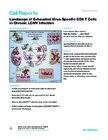Abstract
A hallmark of chronic infections is the presence of exhausted CD8 T cells, characterized by a distinct transcriptional program compared with functional effector or memory cells, co-expression of multiple inhibitory receptors, and impaired effector function, mainly driven by recurrent T cell receptor engagement. In the context of chronic lymphocytic choriomeningitis virus (LCMV) infection in mice, most studies focused on studying splenic virus-specific CD8 T cells. Here, we provide a detailed characterization of exhausted CD8 T cells isolated from six different tissues during established LCMV infection, using single-cell RNA sequencing. Our data reveal that exhausted cells are heterogeneous, adopt organ-specific transcriptomic profiles, and can be divided into five main functional subpopulations: advanced exhaustion, effector-like, intermediate, proliferating, or memory-like. Adoptive transfer experiments showed that these phenotypes are plastic, suggesting that the tissue microenvironment has a major impact in shaping the phenotype and function of virus-specific CD8 T cells during chronic infection. Show more
Permanent link
https://doi.org/10.3929/ethz-b-000438593Publication status
publishedExternal links
Journal / series
Cell ReportsVolume
Pages / Article No.
Publisher
ElsevierOrganisational unit
03625 - Oxenius, Annette / Oxenius, Annette
03984 - Claassen, Manfred (ehemalig) / Claassen, Manfred (former)
09490 - Stadler, Tanja / Stadler, Tanja
More
Show all metadata





